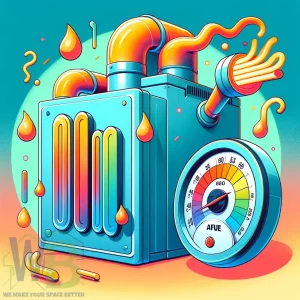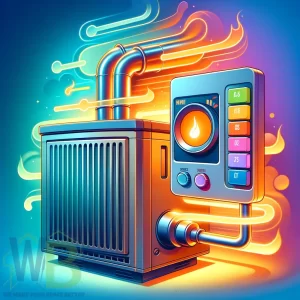When looking at different types of HVAC systems, you’ll often see terms like SEER, AFUE, and HSPF. But what do these ratings mean?
They are all about efficiency. SEER (Seasonal Energy Efficiency Ratio) is used for air conditioners, AFUE (Annual Fuel Utilization Efficiency) for furnaces, and HSPF (Heating Seasonal Performance Factor) for heat pumps.

Quick Summary
| Aspect | SEER Rating | AFUE Rating | HSPF Rating |
|---|---|---|---|
| Definition | Seasonal Energy Efficiency Ratio | Annual Fuel Utilization Efficiency | Heating Seasonal Performance Factor |
| Applies To | Air Conditioners and Heat Pumps (Cooling) | Furnaces | Heat Pumps (Heating) |
| Measures | Cooling Efficiency in a Typical Season | Heating Efficiency Over a Year | Heating Efficiency in a Typical Season |
| Ideal Numbers | Higher is Better (14+) | Higher is Better (90%+) | Higher is Better (8+) |
| Importance | Indicates cooling efficiency & energy use | Reflects heating efficiency & fuel use | Shows heating efficiency & energy use |
| Choosing Tips | Consider climate, home size, & long-term savings | Weigh climate needs, upfront cost vs. savings, & home insulation | Balance with SEER, consider climate impact, & long-term savings |
SEER: Seasonal Energy Efficiency Ratio
What is SEER?
SEER stands for Seasonal Energy Efficiency Ratio. It’s a measure used to rate the efficiency of air conditioners and heat pumps (for cooling). The SEER rating shows how much cooling a system puts out for each energy unit.
Why is SEER Important?
- Energy Savings: The higher the SEER rating, the more efficient the air conditioner. This means lower energy bills.
- Environmental Impact: Efficient units use less energy, which is better for the environment.
- Comfort: High SEER units often provide better and more consistent cooling.
Understanding SEER Numbers
- Range: SEER ratings can range from around 13 to over 20.
- Minimum Standards: In the U.S., the minimum SEER rating for new air conditioners varies by region, from 13 to 14.
- High-Efficiency Models: Models with a SEER rating of 16 or more are considered high-efficiency.
Choosing the Right SEER
- Consider Climate: A higher SEER rating can mean more savings in hot climates.
- Budget: Higher SEER models cost more upfront but can save money in the long run.
- Home Size: Larger homes may need a system with a higher SEER for effective cooling.
–> Remember, while a higher SEER rating indicates more efficiency, it’s just one factor in choosing the right air conditioner. Your specific needs and home environment also play a big role.
AFUE: Annual Fuel Utilization Efficiency
What is AFUE?
AFUE stands for Annual Fuel Utilization Efficiency. It measures how efficiently a furnace can convert the energy in its fuel to heat over a typical year. Unlike SEER, which is for cooling, AFUE is all about heating.
Why is AFUE Important?
- Cost-Effective Heating: A higher AFUE means more fuel becomes heat rather than wasted. This can lower your heating bills.
- Eco-Friendly: Efficient furnaces use less fuel, reducing your carbon footprint.
- Overall Comfort: A higher AFUE rating often means more consistent and effective heating.
Understanding AFUE Numbers
- Range: AFUE ratings typically range from 80% to 98%.
- Minimum Standards: Furnaces must have an AFUE of at least 78% in many places, though newer models often start at 80%.
- High-Efficiency Furnaces: Furnaces with an AFUE of 90% or higher are considered high-efficiency.
Choosing the Right AFUE
- Climate Needs: A higher AFUE can mean significant savings in colder areas.
- Initial Investment vs. Long-Term Savings: High-efficiency furnaces cost more upfront but can save more money over time.
- Home Insulation: Good insulation can enhance the effectiveness of a high AFUE furnace.
AFUE helps you understand how much bang for your buck you’re getting from your furnace in terms of energy use.
HSPF: Heating Seasonal Performance Factor
What is HSPF?
HSPF stands for Heating Seasonal Performance Factor. This rating is used for heat pumps, specifically for their heating efficiency. Like SEER and AFUE, HSPF tells you how effectively the system converts energy into heating.
Why is HSPF Important?
- Energy Efficiency: A higher HSPF means the heat pump uses less energy to provide heat.
- Cost Savings: More efficient heating reduces energy bills, especially in colder months.
- Eco-Friendly Heating: Efficient heat pumps reduce energy consumption and are better for the environment.
Understanding HSPF Numbers
- Range: HSPF ratings typically range from around 7 to 10.
- Minimum Standards: The minimum HSPF for new heat pumps is usually 7.7 or higher.
- High-Efficiency Models: Heat pumps with an HSPF of 8 or above are considered very efficient.
Choosing the Right HSPF
- Climate Impact: A higher HSPF can lead to greater energy savings in cooler climates.
- Balance with SEER: Since heat pumps also provide cooling, balance the HSPF with a good SEER rating.
- Long-Term Savings: Higher HSPF models might cost more upfront but can save you money over time.
HSPF is a crucial factor when selecting a heat pump. It helps you gauge the heating efficiency, impacting your comfort and heating costs.
SEER, AFUE, and HSPF
When choosing an HVAC system, understanding SEER, AFUE, and HSPF ratings is key. These ratings help you find the most efficient and cost-effective option for your home.
Making the Right Choice
- Consider Your Climate: Your local climate will affect which rating is most important for you.
- Balance Efficiency and Cost: Higher ratings usually mean higher prices and more savings in the long run.
- Think Long-Term: Investing in a high-efficiency system can offer long-term savings and environmental benefits.
Remember the Whole Picture
While these ratings are important, they’re not the only things to consider. You should also consider the size of your home, insulation, and specific needs. Sometimes, consulting with a professional can help you make the best choice for your home.







